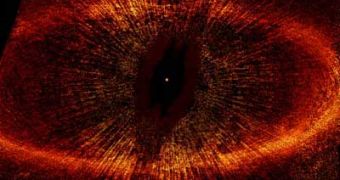Two years ago, Alice Quillen, an astronomer at the University of Rochester, estimated that a planet of a specific size is revolving in a precise orbit in the dust disk surrounding the Formalhaut star. A month ago, the Hubble Space Telescope took a very accurate image of the region, indicating that such a planet exists beyond doubt, strikingly close to the location indicated by Quillen, and that it is also part of a larger planetary system.
This was one of the very rare findings of this type, as generally, the existence of planets is inferred from direct and more precise photographies. The only other such case was the discovery of Neptune in 1846, after it had been inferred to exist based on its influence on Uranus' orbit three years prior to the event. On November 13th this year, Eugene Chiang, an associate professor of astronomy at the University of California at Berkeley, was part of the team that took the planet's picture using the telescope.
"It's remarkable," shared Chiang, as cited by Scientific Blogging. "Alice saw the way the inner edge of the dust ring cut off sharply and recognized that a planet likely orbited just inside. The orbit we found was amazingly close to Alice's prediction." Another similar initiative was attempted in 2004 by experts from the University of Washington, but the image of a planet orbiting a star 217 light years away caught in 2007 was of very poor quality in comparison with the one taken by Quillen and Chiang.
Quillen is conducting assiduous research aimed at fine-tuning the planet predicting process and techniques, involving hydrodynamic fluid-like structures well fit for the rings of fine dust surrounding some stars, as well as the dust particle dynamics in the case of clumpier disk structures present in older systems. This also helped her determine with surprising accuracy the weird elliptical orbit of the new planet that is not typical to such young planetary systems.

 14 DAY TRIAL //
14 DAY TRIAL //